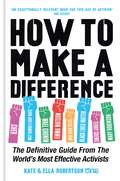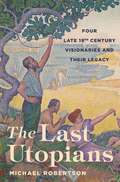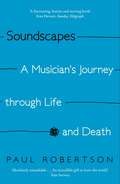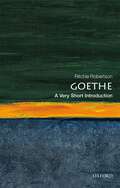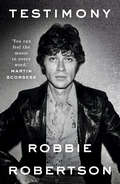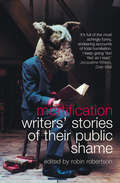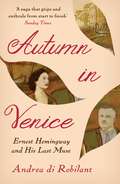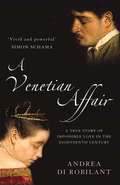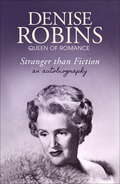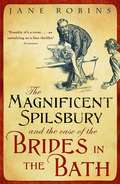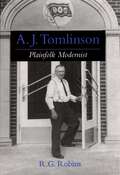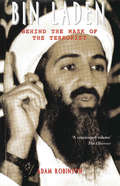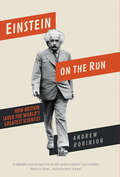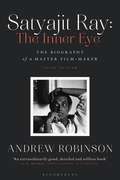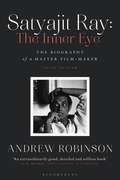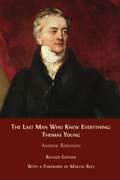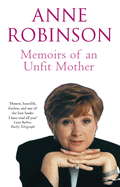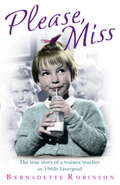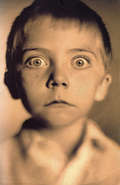- Table View
- List View
Rugby: The Perfect Gift for Rugby Fans
by Ian RobertsonIan Robertson joined the BBC during the golden age of radio broadcasting and was given a crash course in the art of sports commentary from some of the greatest names ever to sit behind a microphone: Cliff Morgan and Peter Bromley, Bryon Butler and John Arlott. Almost half a century after being introduced to the rugby airwaves by his inspiring mentor Bill McLaren, the former Scotland fly-half looks back on the most eventful of careers, during which he covered nine British and Irish Lions tours and eight World Cups, including the 2003 tournament that saw England life the Webb Ellis Trophy and "Robbo" pick up awards for his spine-tingling description of Jonny Wilkinson's decisive drop goal.He reflects on his playing days, his role in guiding Cambridge University to a long spell of Varsity Match supremacy and his relationships with some of the union code's most celebrated figures, including Sir Clive Woodward and Jonah Lomu. He also writes vividly and hilariously of his experiences as a horse racing enthusiast, his meetings with some of the world's legendary golfers and his dealings with a stellar cast of sporting outsiders, from Richard Burton and Elizabeth Taylor to Nelson Mandela. It is a hugely entertaining story that begins in a bygone rugby age, yet has much to say about the game in the here and now.
How to Make a Difference: 300 Simple Ways To make A Difference In Yourself--and The World
by Kate Robertson Ella Robertson"An exceptionally relevant book for this age of activism." Bob GeldofWith a foreword by Kofi Annan, former Secretary-General of the UN (1997-2006).How to Make a Difference is a practical roadmap to modern day activism created by the powerful and imaginative minds behind the world's biggest campaigns including Colin Kaepernick, Emma Watson, Sir Bob Geldof, Fatima Bhutto, Black Lives Matter, Doutzen Kroes, Yeonmi Park, Terry Crews, Cher, Matt Damon, Paul Polman and Gina Miller; collectively they combine the latest models of thinking, their real life experiences, radical techniques and effective advice in order to help incentivize everyone and anyone who has ever wondered, how can I help? From How to Change the Law, How to Protest, How to Use Social Media Effectively, How to End a Problem Forever and How to Change a Big Organization, this book educates as much as it encourages and informs us all to see the world as something that can and must be changed. This book will help you find an active role in positive, necessary activism and meaningful change on every scale across the globe. The only book to pool together the biggest names in activism and showcase how they have used their voices, their networks and their abilities to change the world around us.How to Make a Difference speaks to a generation who are switching selfie-sticks for protest placards and will showcase how everyone has the ability to be the change they want to see in the world.If not now, when? If not you, who?Perfect for fans of This Is Not a Drill, No One Is Too Small to Make a Difference and There Is No Planet B.
The Last Utopians: Four Late Nineteenth-Century Visionaries and Their Legacy
by Michael RobertsonThe entertaining story of four utopian writers—Edward Bellamy, William Morris, Edward Carpenter, and Charlotte Perkins Gilman—and their continuing influence todayFor readers reared on the dystopian visions of Nineteen Eighty-Four and The Handmaid's Tale, the idea of a perfect society may sound more sinister than enticing. In this lively literary history of a time before "Orwellian" entered the cultural lexicon, Michael Robertson reintroduces us to a vital strain of utopianism that seized the imaginations of late nineteenth-century American and British writers.The Last Utopians delves into the biographies of four key figures--Edward Bellamy, William Morris, Edward Carpenter, and Charlotte Perkins Gilman—who lived during an extraordinary period of literary and social experimentation. The publication of Bellamy's Looking Backward in 1888 opened the floodgates of an unprecedented wave of utopian writing. Morris, the Arts and Crafts pioneer, was a committed socialist whose News from Nowhere envisions a workers' Arcadia. Carpenter boldly argued that homosexuals constitute a utopian vanguard. Gilman, a women's rights activist and the author of "The Yellow Wallpaper," wrote numerous utopian fictions, including Herland, a visionary tale of an all-female society.These writers, Robertson shows, shared a belief in radical equality, imagining an end to class and gender hierarchies and envisioning new forms of familial and romantic relationships. They held liberal religious beliefs about a universal spirit uniting humanity. They believed in social transformation through nonviolent means and were committed to living a simple life rooted in a restored natural world. And their legacy remains with us today, as Robertson describes in entertaining firsthand accounts of contemporary utopianism, ranging from Occupy Wall Street to a Radical Faerie retreat.
The Last Utopians: Four Late Nineteenth-Century Visionaries and Their Legacy
by Michael RobertsonThe entertaining story of four utopian writers—Edward Bellamy, William Morris, Edward Carpenter, and Charlotte Perkins Gilman—and their continuing influence todayFor readers reared on the dystopian visions of Nineteen Eighty-Four and The Handmaid's Tale, the idea of a perfect society may sound more sinister than enticing. In this lively literary history of a time before "Orwellian" entered the cultural lexicon, Michael Robertson reintroduces us to a vital strain of utopianism that seized the imaginations of late nineteenth-century American and British writers.The Last Utopians delves into the biographies of four key figures--Edward Bellamy, William Morris, Edward Carpenter, and Charlotte Perkins Gilman—who lived during an extraordinary period of literary and social experimentation. The publication of Bellamy's Looking Backward in 1888 opened the floodgates of an unprecedented wave of utopian writing. Morris, the Arts and Crafts pioneer, was a committed socialist whose News from Nowhere envisions a workers' Arcadia. Carpenter boldly argued that homosexuals constitute a utopian vanguard. Gilman, a women's rights activist and the author of "The Yellow Wallpaper," wrote numerous utopian fictions, including Herland, a visionary tale of an all-female society.These writers, Robertson shows, shared a belief in radical equality, imagining an end to class and gender hierarchies and envisioning new forms of familial and romantic relationships. They held liberal religious beliefs about a universal spirit uniting humanity. They believed in social transformation through nonviolent means and were committed to living a simple life rooted in a restored natural world. And their legacy remains with us today, as Robertson describes in entertaining firsthand accounts of contemporary utopianism, ranging from Occupy Wall Street to a Radical Faerie retreat.
The Last Utopians: Four Late Nineteenth-Century Visionaries and Their Legacy
by Michael RobertsonThe entertaining story of four utopian writers—Edward Bellamy, William Morris, Edward Carpenter, and Charlotte Perkins Gilman—and their continuing influence todayFor readers reared on the dystopian visions of Nineteen Eighty-Four and The Handmaid's Tale, the idea of a perfect society may sound more sinister than enticing. In this lively literary history of a time before "Orwellian" entered the cultural lexicon, Michael Robertson reintroduces us to a vital strain of utopianism that seized the imaginations of late nineteenth-century American and British writers.The Last Utopians delves into the biographies of four key figures--Edward Bellamy, William Morris, Edward Carpenter, and Charlotte Perkins Gilman—who lived during an extraordinary period of literary and social experimentation. The publication of Bellamy's Looking Backward in 1888 opened the floodgates of an unprecedented wave of utopian writing. Morris, the Arts and Crafts pioneer, was a committed socialist whose News from Nowhere envisions a workers' Arcadia. Carpenter boldly argued that homosexuals constitute a utopian vanguard. Gilman, a women's rights activist and the author of "The Yellow Wallpaper," wrote numerous utopian fictions, including Herland, a visionary tale of an all-female society.These writers, Robertson shows, shared a belief in radical equality, imagining an end to class and gender hierarchies and envisioning new forms of familial and romantic relationships. They held liberal religious beliefs about a universal spirit uniting humanity. They believed in social transformation through nonviolent means and were committed to living a simple life rooted in a restored natural world. And their legacy remains with us today, as Robertson describes in entertaining firsthand accounts of contemporary utopianism, ranging from Occupy Wall Street to a Radical Faerie retreat.
The Last Utopians: Four Late Nineteenth-Century Visionaries and Their Legacy
by Michael RobertsonThe entertaining story of four utopian writers—Edward Bellamy, William Morris, Edward Carpenter, and Charlotte Perkins Gilman—and their continuing influence todayFor readers reared on the dystopian visions of Nineteen Eighty-Four and The Handmaid's Tale, the idea of a perfect society may sound more sinister than enticing. In this lively literary history of a time before "Orwellian" entered the cultural lexicon, Michael Robertson reintroduces us to a vital strain of utopianism that seized the imaginations of late nineteenth-century American and British writers.The Last Utopians delves into the biographies of four key figures--Edward Bellamy, William Morris, Edward Carpenter, and Charlotte Perkins Gilman—who lived during an extraordinary period of literary and social experimentation. The publication of Bellamy's Looking Backward in 1888 opened the floodgates of an unprecedented wave of utopian writing. Morris, the Arts and Crafts pioneer, was a committed socialist whose News from Nowhere envisions a workers' Arcadia. Carpenter boldly argued that homosexuals constitute a utopian vanguard. Gilman, a women's rights activist and the author of "The Yellow Wallpaper," wrote numerous utopian fictions, including Herland, a visionary tale of an all-female society.These writers, Robertson shows, shared a belief in radical equality, imagining an end to class and gender hierarchies and envisioning new forms of familial and romantic relationships. They held liberal religious beliefs about a universal spirit uniting humanity. They believed in social transformation through nonviolent means and were committed to living a simple life rooted in a restored natural world. And their legacy remains with us today, as Robertson describes in entertaining firsthand accounts of contemporary utopianism, ranging from Occupy Wall Street to a Radical Faerie retreat.
Soundscapes: A Musician's Journey through Life and Death
by Paul RobertsonFor nearly forty years Paul Robertson performed throughout the world as First Violinist of the internationally renowned Medici String Quartet, of which he was a founder member. In 2008 the main artery to Paul's heart ruptured, leading to him dying on the operating-table, and then being resuscitated. Paul subsequently hovered in a deep coma for six weeks, close to death and experiencing visions, affording him profound insights into the relationship between music and the subconscious When he came to he felt he had been reborn - fundamentally, a different person - and not just because the left side of his body was partially paralysed. Instead, he woke with a completely new acceptance of the meaning of death, and a belief in life beyond. Now 64 years-old, Paul has decided not to undergo any more surgery, facing a very uncertain future and living on borrowed time. In this book Paul reflects on his musical training, his insights into the difficult realities of ensemble playing, and about the possible meaning of his experiences in both life and near-death. This extraordinary and poignant memoir will be for all musicians, spiritual thinkers and musical laymen who have engaged with the rigours of learning music.
Goethe: In The Last Years Of His Life (Very Short Introductions)
by Ritchie RobertsonIn 1878 the Victorian critic Matthew Arnold wrote: 'Goethe is the greatest poet of modern times... because having a very considerable gift for poetry, he was at the same time, in the width, depth, and richness of his criticism of life, by far our greatest modern man.' In this Very Short Introduction Ritchie Robertson covers the life and work of Johann Wolfgang von Goethe (1749-1832): scientist, administrator, artist, art critic and supreme literary writer in a vast variety of genres. Looking at Goethe's poetry, novels and drama pieces, as well as his travel writing, autobiography, and essays on art and aesthetics, Robertson analyses some of the key themes in his works: love, nature, religion and tragedy. Dispelling the misconception of Goethe as a sedate Victorian sage, Robertson shows how much of his art was rooted in turbulent personal conflicts, and draws on recent research to present a complete portrait of the scientific work and political activity which accompanied Goethe's writings. ABOUT THE SERIES: The Very Short Introductions series from Oxford University Press contains hundreds of titles in almost every subject area. These pocket-sized books are the perfect way to get ahead in a new subject quickly. Our expert authors combine facts, analysis, perspective, new ideas, and enthusiasm to make interesting and challenging topics highly readable.
Goethe: A Very Short Introduction (Very Short Introductions)
by Ritchie RobertsonIn 1878 the Victorian critic Matthew Arnold wrote: 'Goethe is the greatest poet of modern times... because having a very considerable gift for poetry, he was at the same time, in the width, depth, and richness of his criticism of life, by far our greatest modern man.' In this Very Short Introduction Ritchie Robertson covers the life and work of Johann Wolfgang von Goethe (1749-1832): scientist, administrator, artist, art critic and supreme literary writer in a vast variety of genres. Looking at Goethe's poetry, novels and drama pieces, as well as his travel writing, autobiography, and essays on art and aesthetics, Robertson analyses some of the key themes in his works: love, nature, religion and tragedy. Dispelling the misconception of Goethe as a sedate Victorian sage, Robertson shows how much of his art was rooted in turbulent personal conflicts, and draws on recent research to present a complete portrait of the scientific work and political activity which accompanied Goethe's writings. ABOUT THE SERIES: The Very Short Introductions series from Oxford University Press contains hundreds of titles in almost every subject area. These pocket-sized books are the perfect way to get ahead in a new subject quickly. Our expert authors combine facts, analysis, perspective, new ideas, and enthusiasm to make interesting and challenging topics highly readable.
Testimony
by Robbie RobertsonRobbie Robertson's singular contributions to popular music have made him one of the most beloved songwriters and guitarists of his time. With songs like ‘The Weight’, ‘The Night They Drove Old Dixie Down’ and ‘Up on Cripple Creek’, he and his partners in the Band fashioned a music that has endured for decades, influencing countless musicians.In this captivating memoir, written over five years of reflection, Robbie employs his unique storyteller's voice to weave together the journey that led him to some of the most pivotal events in music history. He recounts the adventures of his half-Jewish, half-Mohawk upbringing on the Six Nations Indian Reserve and on the gritty streets of Toronto; his odyssey at sixteen to the Mississippi Delta, the fountainhead of American music; the wild, early years on the road with rockabilly legend Ronnie Hawkins and the Hawks; his unexpected ties to the Cosa Nostra underworld; the gripping trial-by-fire of 'going electric' with Bob Dylan on his 1966 world tour and their ensuing celebrated collaborations; the formation of the Band and the forging of their unique sound, culminating with history’s most famous farewell concert, brought to life for all time in Martin Scorsese’s great movie The Last Waltz. This is the story of a time and place - the moment when rock 'n' roll became life, when legends like Buddy Holly and Bo Diddley crisscrossed the circuit of clubs and roadhouses from Texas to Toronto, when the Beatles, Hendrix, the Stones and Warhol moved through the same streets and hotel rooms. It’s the story of exciting change as the world tumbled through the '60s and early '70s and a generation came of age, built on music, love and freedom. Above all, it’s the moving story of the profound friendship among five young men who together created a new kind of popular music. Testimony is Robbie Robertson’s story, lyrical and true, as only he could tell it.
Mortification: Writers' Stories Of Their Public Shame
by Robin RobertsonA collection of stories from some of the world’s greatest writers about their own public humiliation.
Autumn in Venice: Ernest Hemingway and His Last Muse
by Andrea di RobilantNational Geographic Traveller's the best books on European cities, 2019In the autumn of 1948 Hemingway was approaching fifty and hadn't published a novel in nearly a decade. He travelled for the first time to Venice and there, at a duck shoot in the lagoon he met and fell in love with Adriana Ivancich, a striking young Venetian woman just out of finishing school. What followed was a platonic love affair; he continued to visit her in Venice; she in turn came to Cuba while he wrote The Old Man and the Sea. This is the illuminating story of a writer and a muse that intimately examines both the cost to Adriana and the fractured heart and changing art of Hemingway in his fifties.'Hemingway [is] an enduringly fascinating character, one whom di Robilant, with his easy-paced style, has sympathetically brought to life.' Literary Review'Effortlessly and expertly explores the secret desires, successes, and depressive obstacles that shrouded Ernest Hemingway's final productive years.' New York Journal of Books
A Venetian Affair: A True Story Of Impossible Love In The Eighteenth Century (text Only)
by Andrea di RobilantThe true story of forbidden love in eighteenth-century Venice between an Italian noble and the brilliant, illegitimate daughter of an English baronet.
Oscar Wilde -- The Great Drama of His Life: How His Tragedy Reflected His Personality
by Ashley RobinsIn the 1890s Oscar Wilde enjoyed one of the most high-profile reputations in Britain; yet, virtually overnight, he was plunged into disgrace and ruin. What were the reasons for this extraordinary reversal of fortune? Ashley Robins explores Wilde's motivation in prosecuting the Marquess of Queensberry, and elaborates on the precarious legal situation that effectively quashed any prospect of a withdrawal from the lawsuit without dire consequences. He examines the medical and psychiatric aspects of Wilde's two-year imprisonment and reveals -- for the first time and based on the original Home Office records -- the machinations among prison officials and doctors to cover up Wilde's state of health. Wilde's medical history is presented with an expert evaluation of his terminal illness, including a resolution of the syphilis controversy. Robins details Wilde's tangled matrimonial affairs during his imprisonment and goes on to disclose the manoeuvres adopted by friends to secure his early release, citing hitherto unpublished letters to show that bribery of prison personnel was seriously contemplated. The issue of homosexuality is discussed not only in relation to Oscar Wilde but from the broader historical, legal and biological perspective. The author portrays Wilde's character and behaviour through the images he projected onto society, by the strong but mixed public reaction to him, and by the quality of his interpersonal relationships with his wife, family and close friends. Finally, Wilde's personality is assessed using internationally accepted diagnostic criteria; and, in an unusual and innovative experiment, a group of Wildean scholars completed a psychological questionnaire as if they were doing so for Oscar Wilde himself. Drawing on these findings and on his own extensive psychiatric experience, Ashley Robins concludes that Wilde had a disorder of personality that culminated in the final and tragic phase of his life.
Stranger than Fiction
by Denise RobinsThe autobiography of Denise Robins, the 100-million-copy bestselling Queen of Romance, first published in 1965, and available now for the first time in eBook.Apart from writing over two hundred novels which have sold over one hundred million copies worldwide, Denise Robins led a remarkable life. Love and romance were always dominant influences and were reflected not only in her work but in her attitude to life. All the warmth, compassion and deep understanding of the frailty if the human heart that shine through her novels, can be seen here in her autobiography. It is a story that will captivate her huge audience of readers.
The Magnificent Spilsbury and the Case of the Brides in the Bath
by Jane RobinsBessie Mundy, Alice Burnham and Margaret Lofty are three women with one thing in common. They are spinsters and are desperate to marry. Each woman meets a smooth-talking stranger who promises her a better life. She falls under his spell, and becomes his wife. But marriage soon turns into a terrifying experience. In the dark opening months of the First World War, Britain became engrossed by 'The Brides in the Bath' trial. The horror of the killing fields of the Western Front was the backdrop to a murder story whose elements were of a different sort. This was evil of an everyday, insidious kind, played out in lodging houses in seaside towns, in the confines of married life, and brought to a horrendous climax in that most intimate of settings -- the bathroom. The nation turned to a young forensic pathologist, Bernard Spilsbury, to explain how it was that young women were suddenly expiring in their baths. This was the age of science. In fiction, Sherlock Holmes applied a scientific mind to solving crimes. In real-life, would Spilsbury be as infallible as the 'great detective'?
A. J. Tomlinson: Plainfolk Modernist (Religion in America)
by R. G. RobinsA.J. Tomlinson (1865-1943) ranks among the leading figures of the early Pentecostal movement, and like so many of his cohorts, he was as complex as he was colorful. Arriving in Appalachia as a home missionary determined to uplift and evangelize poor mountain whites, he stayed to become the co-founder and chief architect of the Church of God (Cleveland, TN) and the Church of God of Prophecy, which together with their minor offspring now constitute the third-largest denominational family within American Pentecostalism. R.G. Robins's biography recreates the world in which Tomlinson operated, and through his story offers a new understanding of the origins of the Pentecostal movement. Scholars have tended to view Pentecostalism as merely one among many anti-modernist movements of the early twentieth century. Robins argues that this is a misreading of the movement's origins-the result of projecting the modernist/fundamentalist controversy of the 1920s back onto the earlier religious landscape. Seeking to return the story of Pentecostalism to its proper historical context, Robins suggests that Pentecostalism should rightly be seen as an outgrowth of the radical holiness movement of the late nineteenth century. He argues that, far from being anti-modern, Pentecostals tended to embrace modernity. Pentecostal modernism, however, was a working class or "plainfolk" phenomenon, and it is the plainfolk character of the movement that has led so many scholars to mislabel it as anti-modern or fundamentalist. Through the compelling narrative of Tomlinson's life story, Robins sheds new light on late-nineteenth and early-twentieth century American religion, and provides a more refined lens through which to view the religious dynamics of our own day. v
Bin Laden: Behind the Mask of the Terrorist
by Adam RobinsonA zealous freedom-fighter who has galvanised Islamic fundamentalists worldwide into a fighting force capable of toppling evil western civilisation. A simple man, pious, upstanding and principled; the moral leader of the faithful. This is the image that Osama bin Laden wishes to project to the world. Now, for the first time, Bin Laden: Behind the Mask of the Terrorist blows the lid off the inside story. The first real insight into the life of the renegade phophet of the apocalypse reveals a past laced with prostitutes, hedonism, and lengthy periods of alcohol abuse. Beneath the self-styled propaganda is a hypocrite whose personal mission is nothing less than the destruction of the United States and her allies in the name of Islam. This is the man who deftly manipulates the institutions he claims to despise in order to further his own ends; who condemns depravity while keeping a hand in the opium and heroin trade. With new information provided by members of his family, the book traces the roots of his dicontent, exploring his privileged childhood riven by jealousies and family polotics. It paints the picture of a youth desperately seeking acceptance and a man whose need for attention and adulation set him upon an unbelievable course.
Einstein on the Run: How Britain Saved the World's Greatest Scientist
by Andrew RobinsonThe first account of the role Britain played in Einstein's life—first by inspiring his teenage passion for physics, then by providing refuge from the Nazis In autumn 1933, Albert Einstein found himself living alone in an isolated holiday hut in rural England. There, he toiled peacefully at mathematics while occasionally stepping out for walks or to play his violin. But how had Einstein come to abandon his Berlin home and go ‘"on the run"? In this lively account, Andrew Robinson tells the story of the world’s greatest scientist and Britain for the first time, showing why Britain was the perfect refuge for Einstein from rumored assassination by Nazi agents. Young Einstein’s passion for British physics, epitomized by Newton, had sparked his scientific development around 1900. British astronomers had confirmed his general theory of relativity, making him internationally famous in 1919. Welcomed by the British people, who helped him campaign against Nazi anti-Semitism, he even intended to become a British citizen. So why did Einstein then leave Britain, never to return to Europe?
Satyajit Ray: The Biography of a Master Film-Maker
by Andrew RobinsonAkira Kurosawa said of the great director: 'Not to have seen the cinema of Ray means existing in the world without seeing the sun or the moon.' Martin Scorsese remarked on Ray's birth centenary in 2021: 'The films of Satyajit Ray are truly treasures of cinema, and everyone with an interest in film needs to see them.'Satyajit Ray: The Inner Eye is the definitive biography, based on extensive interviews with Ray himself, his actors and collaborators, and a deep knowledge of Bengali culture. Andrew Robinson provides an in-depth critical account of each film in an astonishingly versatile career, from Ray's directorial debut Pather Panchali (1955) to his final feature Agantuk (1991). The third (centenary) edition includes new material: an epilogue, 'A century of Ray', about the nature of his genius; a wide-ranging conversation with Ray drawn from the author's interviews; and an updated comprehensive bibliography of Ray's writings.
Satyajit Ray: The Biography of a Master Film-Maker
by Andrew RobinsonAkira Kurosawa said of the great director: 'Not to have seen the cinema of Ray means existing in the world without seeing the sun or the moon.' Martin Scorsese remarked on Ray's birth centenary in 2021: 'The films of Satyajit Ray are truly treasures of cinema, and everyone with an interest in film needs to see them.'Satyajit Ray: The Inner Eye is the definitive biography, based on extensive interviews with Ray himself, his actors and collaborators, and a deep knowledge of Bengali culture. Andrew Robinson provides an in-depth critical account of each film in an astonishingly versatile career, from Ray's directorial debut Pather Panchali (1955) to his final feature Agantuk (1991). The third (centenary) edition includes new material: an epilogue, 'A century of Ray', about the nature of his genius; a wide-ranging conversation with Ray drawn from the author's interviews; and an updated comprehensive bibliography of Ray's writings.
The Last Man Who Knew Everything Thomas Young: (pdf)
by Andrew Robinson Martin ReesNo one has given the polymath Thomas Young (1773–1829) the all-round examination he so richly deserves—until now. Celebrated biographer Andrew Robinson portrays a man who solved mystery after mystery in the face of ridicule and rejection, and never sought fame. As a physicist, Young challenged the theories of Isaac Newton and proved that light is a wave. As a physician, he showed how the eye focuses and proposed the three-colour theory of vision, only confirmed a century and a half later. As an Egyptologist, he made crucial contributions to deciphering the Rosetta Stone. It is hard to grasp how much Young knew. This biography is the fascinating story of a driven yet modest hero who cared less about what others thought of him than for the joys of an unbridled pursuit of knowledge—with a new foreword by Martin Rees and a new postscript discussing polymathy in the two centuries since the time of Young. It returns this neglected genius to his proper position in the pantheon of great scientific thinkers.
Memoirs of an Unfit Mother
by Anne RobinsonAnne Robinson's mother was a cross between Robert Maxwell and Mother Teresa. When Anne became a young reporter in Fleet Street, her mother, a wealthy market trader, bought her a mink coat and told her to have a facial once a month.But Anne Robinson's early success almost ended in her destruction. A doomed marriage was followed by a secret custody battle for her two-year-old daughter, Emma. 'Is it true?' her husband's barrister demanded in court, 'you once said you'd rather cover the Vietnam War than vacuum the sitting room?'A shocking, funny, poignant and honest account of three generations of women: Anne's formidable mother, Anne and her daughter Emma. Memoirs of an Unfit Mother tells of Anne's downfall, the shame of the years after the custody battle and her subsequent alcoholism. And the triumph of returning to take a second go at life. And making it work.
Please, Miss: The true story of a trainee teacher in 1960s Liverpool
by Bernadette RobinsonBernadette was just ten years old when her father packed her off to a convent school in Dublin. Seven gruelling years later, she returned home to Liverpool at the start of the swinging sixties. Bernadette had dreamed of being a teacher ever since she was a little girl so she promptly began a course at teacher training college, determined to give children the sort of education she wished she'd had. Bernadette got her first job at 21, teaching five to seven year olds in a school in one of Liverpool's toughest slum areas. The poverty and deprivation she saw at the school shocked her to the core. Children would frequently turn up shoeless and starving, but gradually Bernadette could see she was making a real difference to their lives, and found that teaching changed her own life in ways she hadn't expected... Rich in period detail, PLEASE, MISS is an uplifting and moving book that opens a window onto the colourful and fascinating world of 1960s Liverpool.
The Peculiar Memories of Thomas Penman
by Bruce RobinsonThe Peculiar Memories of Thomas Penman is the acclaimed autobiographical debut novel by Oscar-winning screenwriter Bruce Robinson, the author of Withnail and I. This is the story of a dysfunctional family. It is about a boy and his grandpa, life and death, sex and hate, dog's meat and cancer. It is also about pornography, enemas, Morse codes, puberty, secrets, God and loathing. It is also about love.

